At interest.co.nz we love charts and spreadsheets. We think they help explain what's happening to our economy and society and why interest rates, house prices and the other key indicators move the way they do. David Chaston, our publisher, does a wonderful job of regularly updating our databases of economic and market information. I then gleefully pounce on them and work them into our articles. I think they help make our site special. Here's 11 charts that I think explain why the Labour-led government has failed to deliver the type of economic growth needed to keep our best and brightest (and eventually their parents) from leaving the country. I'm not terribly enthused about the possible alternative, but it does offer a smidgen of hope that a decade-long decline can be turned around. 1. Productivity growth has slumped under the Labour-led government 2. The after tax income gap with Australia has widened under Labour 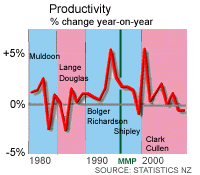 Everything comes back to productivity in the end. It is a bugger to measure and it's hard to comprehend sometimes why it's so important, but it is. Ensuring the amount of goods and services produced from every hour of work and every dollar of capital keep growing is crucial to economic growth. Without growth in productivity, it's impossible to sustainably increase real pre-tax wages per capita. Wages can grow fast, but if they move ahead of productivity growth then they're sure to either increase inflation or unemployment, or both. The performance over the last decade has been woeful. There are many reasons for this, often detailed with the charts below. The stunning growth of central and local government are partly to blame. Many more people have been employed in the core bureaucracy in Wellington and in the satellite bureaucracies of local government and health boards. The obvious tax increase imposed in 2000 with the introduction of the 39 cent tax rate has had enormously damaging and unforseen effects. The stealth tax increase through bracket creep did more. The other stealth tax increase has come from a rampant local government sector increasing rates without restraint by Labour. Meanwhile, infrastructure spending in health, schools, roads and broadband has been weak and sporadic.
Everything comes back to productivity in the end. It is a bugger to measure and it's hard to comprehend sometimes why it's so important, but it is. Ensuring the amount of goods and services produced from every hour of work and every dollar of capital keep growing is crucial to economic growth. Without growth in productivity, it's impossible to sustainably increase real pre-tax wages per capita. Wages can grow fast, but if they move ahead of productivity growth then they're sure to either increase inflation or unemployment, or both. The performance over the last decade has been woeful. There are many reasons for this, often detailed with the charts below. The stunning growth of central and local government are partly to blame. Many more people have been employed in the core bureaucracy in Wellington and in the satellite bureaucracies of local government and health boards. The obvious tax increase imposed in 2000 with the introduction of the 39 cent tax rate has had enormously damaging and unforseen effects. The stealth tax increase through bracket creep did more. The other stealth tax increase has come from a rampant local government sector increasing rates without restraint by Labour. Meanwhile, infrastructure spending in health, schools, roads and broadband has been weak and sporadic.
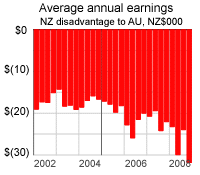 A combination of a succession of tax cuts in Australia, higher taxes in New Zealand and stronger economic growth in Australia in the last couple of years have widened the gap between Australian pre-tax and after tax wages and those in New Zealand. This is not just about Australia having mines and New Zealand not having mines. More than 75% of Australian workers are in the services sector, often working in education, health, financial services, entertainment and the food sector. The China boom has helped, but it is not the only. We've also had something of a China boom in dairy. Wages are on average 30% or so higher and the gap has been widening. What is being done to turn it around or provide some hope it might be turned around? Labour gave up talking about lifting New Zealand back into the top half of the OECD years ago. We are falling further behind. 3. We are losing 129 people a day who migrate to Australia.
A combination of a succession of tax cuts in Australia, higher taxes in New Zealand and stronger economic growth in Australia in the last couple of years have widened the gap between Australian pre-tax and after tax wages and those in New Zealand. This is not just about Australia having mines and New Zealand not having mines. More than 75% of Australian workers are in the services sector, often working in education, health, financial services, entertainment and the food sector. The China boom has helped, but it is not the only. We've also had something of a China boom in dairy. Wages are on average 30% or so higher and the gap has been widening. What is being done to turn it around or provide some hope it might be turned around? Labour gave up talking about lifting New Zealand back into the top half of the OECD years ago. We are falling further behind. 3. We are losing 129 people a day who migrate to Australia. 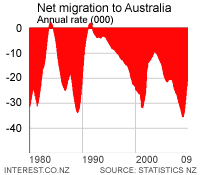 The is the end result of the chart above. New Zealand net migration to Australia hit a record 33,929 in the year to September, beating the previous record of 33,703 in the year to January 1989. The gross figure in the year to September was 47,166 or 129 per day. Since November 1999 a gross 306,452 people have left New Zealand, while net migration was 189,801. This number was at least four times larger than the margin of victory for Labour in the 2005 election of 45,506. This is a national disaster every day. People trained and invested in here by their own families and our government are leaving this land to produce wealth across the Tasman. Obviously, people can't be chained here or blocked from going. But we must provide the choices and incomes to stay here or at least have an option to come back to start families or rejoin ageing parents. The most worrying thing about this exodus is that a good chunk of them are now ageing New Zealanders who are leaving to live in Australia with their own children so they can see their grand kids grow up. 4. Wellington bureaucrat numbers have exploded under Labour
The is the end result of the chart above. New Zealand net migration to Australia hit a record 33,929 in the year to September, beating the previous record of 33,703 in the year to January 1989. The gross figure in the year to September was 47,166 or 129 per day. Since November 1999 a gross 306,452 people have left New Zealand, while net migration was 189,801. This number was at least four times larger than the margin of victory for Labour in the 2005 election of 45,506. This is a national disaster every day. People trained and invested in here by their own families and our government are leaving this land to produce wealth across the Tasman. Obviously, people can't be chained here or blocked from going. But we must provide the choices and incomes to stay here or at least have an option to come back to start families or rejoin ageing parents. The most worrying thing about this exodus is that a good chunk of them are now ageing New Zealanders who are leaving to live in Australia with their own children so they can see their grand kids grow up. 4. Wellington bureaucrat numbers have exploded under Labour 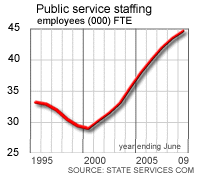 The government is eating the economy. Nowhere is this more apparent than in Wellington, where employment growth in the big ministries of Social Development, Health and Education have turboed already strong growth coming from a bewildering range of new quangos and commissions. New Zealand cannot policy analyse its way to greatness. These people should be out building businesses or providing a direct public service rather than writing reports about writing reports or writing reports about other reports. They are often paid over NZ$100k a year and have certainly not improved productivity in the public sector. 5. Local body rates and charges are growing much faster than inflation
The government is eating the economy. Nowhere is this more apparent than in Wellington, where employment growth in the big ministries of Social Development, Health and Education have turboed already strong growth coming from a bewildering range of new quangos and commissions. New Zealand cannot policy analyse its way to greatness. These people should be out building businesses or providing a direct public service rather than writing reports about writing reports or writing reports about other reports. They are often paid over NZ$100k a year and have certainly not improved productivity in the public sector. 5. Local body rates and charges are growing much faster than inflation 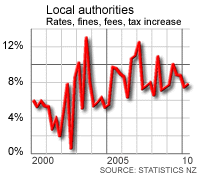 The Labour-led government has either encouraged, forced or allowed an explosion in local body spending on bureaucracy. New building regulations and a raft of various bits of red tape around resource consents and local infrastructure had led to an explosion in wasteful spending that has been paid for by ratepayers. The Reserve Bank is so worried about the inflationary impact of this growth it has warned it wanted to see local body costs growth slow before it will decide on the speed and size of future interest rate cuts. Any new government has to rein in this cost growth and find new ways for local infrastructure to be built and funded using infrastructure bonds rather than current rates. 6. House prices exploded under Labour and it is partly to blame
The Labour-led government has either encouraged, forced or allowed an explosion in local body spending on bureaucracy. New building regulations and a raft of various bits of red tape around resource consents and local infrastructure had led to an explosion in wasteful spending that has been paid for by ratepayers. The Reserve Bank is so worried about the inflationary impact of this growth it has warned it wanted to see local body costs growth slow before it will decide on the speed and size of future interest rate cuts. Any new government has to rein in this cost growth and find new ways for local infrastructure to be built and funded using infrastructure bonds rather than current rates. 6. House prices exploded under Labour and it is partly to blame 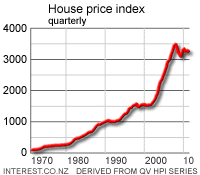 House prices have more than doubled since 1999 because of a swathe of factors, some of which can be sheeted back to either actions or inaction by the Labour-led government. The decision in 2000 to impose the 39 cent tax rate triggered a raft of tax avoidance behaviour, focused around the purchase of rental investment properties and the use of Loss Attributing Qualifying Companies to offset rental losses against personal income (More on this below). A sharp rise in the creation of family trusts with a 33% tax rate was also linked to the rental property boom. Westpac's Brendan O'Donovan estimates the 39% tax rate added at least 20% to house prices. Of course the rampant growth in foreign borrowing by banks that was then passed on to home and investment property buyers in the form of cheap fixed rate mortgages also had a major impact. But the Labour-led government's inability or lack of nous or political will to stop it makes it culpable. Its attempts to provide other forms of finance through Welcome Home and Home Equity loans simply added fuel to the fire. 7. The use of tax losses from LAQCs should have been shut down earlier
House prices have more than doubled since 1999 because of a swathe of factors, some of which can be sheeted back to either actions or inaction by the Labour-led government. The decision in 2000 to impose the 39 cent tax rate triggered a raft of tax avoidance behaviour, focused around the purchase of rental investment properties and the use of Loss Attributing Qualifying Companies to offset rental losses against personal income (More on this below). A sharp rise in the creation of family trusts with a 33% tax rate was also linked to the rental property boom. Westpac's Brendan O'Donovan estimates the 39% tax rate added at least 20% to house prices. Of course the rampant growth in foreign borrowing by banks that was then passed on to home and investment property buyers in the form of cheap fixed rate mortgages also had a major impact. But the Labour-led government's inability or lack of nous or political will to stop it makes it culpable. Its attempts to provide other forms of finance through Welcome Home and Home Equity loans simply added fuel to the fire. 7. The use of tax losses from LAQCs should have been shut down earlier 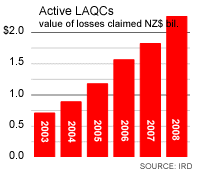 There is some talk that the Inland Revenue Department is cracking down on the use and abuse of LAQCs to offset rental property losses against personal income. But everyone could see this coming and yet neither the government or IRD could or would do anything to stop it. The Reserve Bank murmured about ring-fencing investment property losses from personal income but didn't follow through with it. To be fair to Labour, the National Party has been depressingly silent on this too. Neither want to upset their friends, family and colleagues in the Baby Boomer who have made out like bandits because of the property boom at the expense of younger and poorer generations. 8. Wage inflation has been driven by big wage increases for public servants
There is some talk that the Inland Revenue Department is cracking down on the use and abuse of LAQCs to offset rental property losses against personal income. But everyone could see this coming and yet neither the government or IRD could or would do anything to stop it. The Reserve Bank murmured about ring-fencing investment property losses from personal income but didn't follow through with it. To be fair to Labour, the National Party has been depressingly silent on this too. Neither want to upset their friends, family and colleagues in the Baby Boomer who have made out like bandits because of the property boom at the expense of younger and poorer generations. 8. Wage inflation has been driven by big wage increases for public servants 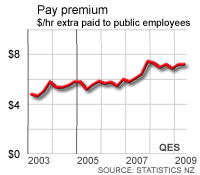 Wage growth in the public sector has been a major factor driving wage inflation and domestic inflation generally in the last two years in particular. Hefty increases have been given to nurses, doctors and teachers to stop them leaving the country, but it has not been matched by productivity increases. If anything, productivity in the health sector has gone down as the layers of bureaucracy at health board level have smothered output and frustrated people at the coalface. The Quarterly Employment Survey (QES) this week showed Wellington wage growth running at 7.2% in the year to the September quarter, which was well above the 5.5% seen nationally. Wellington has the highest incomes in the country now. The QES data also shows that public-sector hourly wages nationally were at $30.83 compared with $22.69 for the private sector. The annual increases were 6.4% and 5.1% respectively for public and private in the September quarter. 9. New Zealand's tax disadvantage with Australia has worsened since 1999
Wage growth in the public sector has been a major factor driving wage inflation and domestic inflation generally in the last two years in particular. Hefty increases have been given to nurses, doctors and teachers to stop them leaving the country, but it has not been matched by productivity increases. If anything, productivity in the health sector has gone down as the layers of bureaucracy at health board level have smothered output and frustrated people at the coalface. The Quarterly Employment Survey (QES) this week showed Wellington wage growth running at 7.2% in the year to the September quarter, which was well above the 5.5% seen nationally. Wellington has the highest incomes in the country now. The QES data also shows that public-sector hourly wages nationally were at $30.83 compared with $22.69 for the private sector. The annual increases were 6.4% and 5.1% respectively for public and private in the September quarter. 9. New Zealand's tax disadvantage with Australia has worsened since 1999 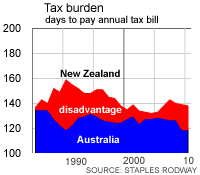 Debates about tax differences between Australia and New Zealand can get awfully complicated very quickly. Australia has GST, income, state and payroll taxes, while New Zealand has income, GST and local body rates. But this chart here shows the number of days of work needed to pay the annual tax bill has rebounded since 2002 while the similar statistic for Australia has been flat. There aren't too many surprises then why so many are leaving for Australia. There are better job opportunities, higher wages, lower taxes and the weather is better. 10. Home building has drifted lower for most of the last five years despite a housing boom
Debates about tax differences between Australia and New Zealand can get awfully complicated very quickly. Australia has GST, income, state and payroll taxes, while New Zealand has income, GST and local body rates. But this chart here shows the number of days of work needed to pay the annual tax bill has rebounded since 2002 while the similar statistic for Australia has been flat. There aren't too many surprises then why so many are leaving for Australia. There are better job opportunities, higher wages, lower taxes and the weather is better. 10. Home building has drifted lower for most of the last five years despite a housing boom 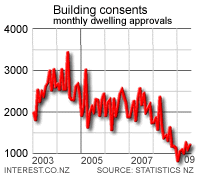 New Zealand has become very poor at building new houses in the last 5 years for a bunch of reasons, some of which this Labour-led government can be blamed for. Building regulations after the leaky buildings debacle were no doubt done for the right reasons but have led to a massive increase in the cost and time involved in getting building consents. Skilled construction labour has been difficult to find, either because of a lack of training or many have left the country for higher wages elsewhere. All sorts of restrictions at local body and national level on opening up new land for housing has restricted new building too. Restrictions on funding new water, sewerage and roading infrastructure at a local level have helped drive down dwelling consents. This helped extend the scale and length of the house price boom from 2003 to 2007. 11. Yet with all the government spending violent crime has increased
New Zealand has become very poor at building new houses in the last 5 years for a bunch of reasons, some of which this Labour-led government can be blamed for. Building regulations after the leaky buildings debacle were no doubt done for the right reasons but have led to a massive increase in the cost and time involved in getting building consents. Skilled construction labour has been difficult to find, either because of a lack of training or many have left the country for higher wages elsewhere. All sorts of restrictions at local body and national level on opening up new land for housing has restricted new building too. Restrictions on funding new water, sewerage and roading infrastructure at a local level have helped drive down dwelling consents. This helped extend the scale and length of the house price boom from 2003 to 2007. 11. Yet with all the government spending violent crime has increased 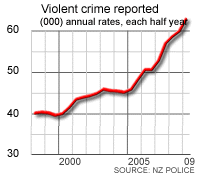 Eventually a government in power for 9 years has to take responsibility for the growth in reported violent crime since 1999. Some might say this is purely due to the reduced stigma attached to reporting domestic violence and the extra police able to take in the reports of this violence. But the proof can be seen in the number of violent crime incidents reported as murders, assaults, sexual attacks and child killings. This can't be explained away as simply more battered women reporting beatings. Surely all the extra money spent on Social Welfare, Child Youth and Family, Justice, Police, Education and Health has to improve this basic metric of life in any society? Apparently not. Something has to change. The latest opinion polls suggest it may not. We'll see on Saturday night.
Eventually a government in power for 9 years has to take responsibility for the growth in reported violent crime since 1999. Some might say this is purely due to the reduced stigma attached to reporting domestic violence and the extra police able to take in the reports of this violence. But the proof can be seen in the number of violent crime incidents reported as murders, assaults, sexual attacks and child killings. This can't be explained away as simply more battered women reporting beatings. Surely all the extra money spent on Social Welfare, Child Youth and Family, Justice, Police, Education and Health has to improve this basic metric of life in any society? Apparently not. Something has to change. The latest opinion polls suggest it may not. We'll see on Saturday night.
Opinion: 11 charts showing why we need a new government
Opinion: 11 charts showing why we need a new government
7th Nov 08, 5:21pm
by

We welcome your comments below. If you are not already registered, please register to comment.
Remember we welcome robust, respectful and insightful debate. We don't welcome abusive or defamatory comments and will de-register those repeatedly making such comments. Our current comment policy is here.